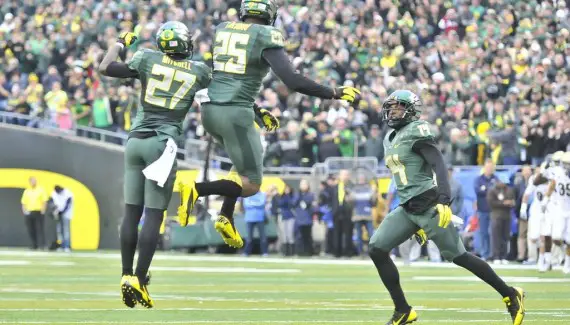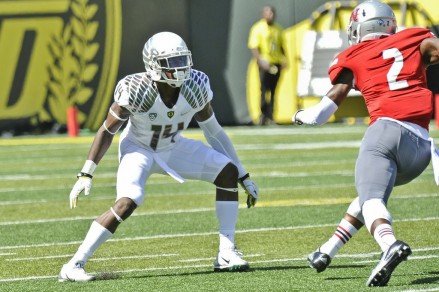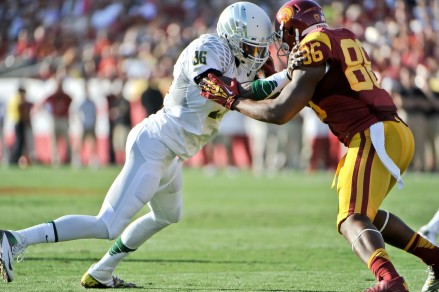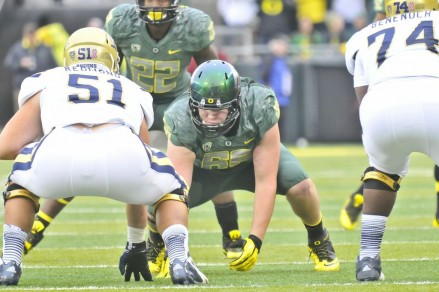Kevin Cline
“Oregon only wins because of its offense.” Everyone knows that, even though it’s not true. In fact, it is so deeply ingrained in everyone’s mind, that outside of the state, people rarely even bother to consider the Ducks’ D.
Regardless of how this season finishes, the 2013 college football campaign has a clear-cut top tier consisting of Alabama, Oregon and Florida State. It appears as though two of these three teams will likely battle for the national championship.
However, there does not appear to be quite enough respect to go ’round.
Two weeks ago, on Sunday’s BCS Countdown show, Kirk Herbstreit claimed that FSU was a more balanced, dominant team than the Ducks. Perhaps he forgot that Oregon had held Brett Hundley, likely a future first-round pick, to 64 passing yards the day prior.
Perhaps he also forgot that Oregon has won every game this season by at least 21 points, including ranked Washington and UCLA teams. Sure, the Seminoles have looked great. In fact, they’ve looked dominant, and they’ve looked balanced, but that does not warrant false claims based on old stereotypes involving Oregon.
The general consensus seems to be as follows: If Alabama wins out, it will be in the national championship game. If the Ducks win out, they, too, will get the chance to play for the title. However, this jump over Florida State is seen generally as resulting from Oregon’s tougher schedule going forward, and not because they are more talented.
In the eyes of the country, Oregon’s perceived weakness always comes down to defense.
It is a well-established “fact” of college football that Oregon has a great offense, but a relatively weak, porous defense. ‘Bama and Florida State, on the other hand, are elite on both sides of the ball. To be fair, many of the numbers would indicate that this is true. However, most are not looking at the right numbers, and many are not watching Oregon play.
If they were, they would know that Oregon’s defense has caught up to its offense. It has arrived on college football’s elite stage and can keep up with the best of ’em.
In fact, the Ducks’ defense is arguably the best it’s ever been, and has been rising ever since the Chip Kelly era began in 2009.
Most fans and analysts would consider the respective defenses of FSU and Alabama to be elite, while Oregon does not usually fall under the same category. Let’s break down the numbers.
Florida State and Alabama are both among the nation’s Top-7 in total defense, each allowing fewer than 290 yards per game. Oregon, on the other hand, is allowing 359 total yards per game. What few seem to realize, or at least admit, is that Oregon’s total defensive stats will always be skewed for one simple reason – time of possession.
The Ducks hold the ball for only 26 minutes per game. Meanwhile, Florida State holds the ball for more than 31 minutes per game, and Alabama holds it for more than 33 minutes per game! This huge disparity results from Oregon’s ability to score quickly (in a Blur) on offense.
Therefore it is important to look at averages, rather than total stats, to truly get a feel for who the Ducks really are. When looking at these averages it becomes clear that Oregon’s defense is elite.
In terms of total yards allowed per defensive snap, Florida State, Oregon and Alabama sit at No. 4 (4.28), No. 7 (4.41) and No. 15 (4.81) respectively. That means the Ducks are Top-10 in terms of yards-per-play allowed, despite having faced 652 total plays this season compared to Alabama’s 467 and FSU’s 538.
While defensive coordinator Nick Aliotti does rapidly rotate players, factoring in human elements such as fatigue makes this statistic even more impressive. Just to reiterate, Oregon is allowing fewer yards per play than Alabama. In fact, not a single SEC team leads the Ducks in this category.
A perfect example of Oregon’s deceiving defensive numbers comes in terms of passing defense. FSU sits at No. 2 in the nation in this category, while Alabama comes in at No. 8 and Oregon sits in the middle of the pack at No. 58.
However, in terms of passing yards allowed per attempt, Oregon, FSU and Alabama sit at No. 2 (5.3), No. 3 (5.4) and No. 22 (6.3) respectively. Once again, the Ducks prove to be elite. This is despite facing more than 13 additional pass attempts per game than both the Tide and Seminoles.
The same goes for rushing defense. Most would not consider Oregon’s ground defense to be in the same tier as Florida State and Alabama. Not surprisingly, to anyone actually paying attention, all three teams are literally tied at 3.41 yards-per-rushing-attempt-allowed.
As we all know, the primary job of the defense is to prevent points. Therefore, it is important to see how these teams stack up in the red zone. Looking at red-zone scoring allowed, Alabama, Oregon and FSU sit at No. 10 (69.23%), No.13 (70.83%) and No. 30 (77.8%) respectively (The percentages here are the percent of red zone trips by opponents that ended in scoring).
The Ducks play defense the same way they play offense. They fly around the field at an unbelievable clip, and have a habit of making big plays.
Oregon is No. 6 in the nation with 23 takeaways while Florida State has 16 and Alabama gained 12. The higher number of defensive snaps does account for some of this disparity, but likely not all.
If fans and analysts want to play the “balance” card, the Ducks can play all day. Along with all of those amazing defensive numbers, Oregon leads the nation in touchdowns with 62, sits at No. 2 in the nation with 632 total yards-per-game and No. 3 in the nation in turnover margin.
Going back to averages, Oregon’s yards-per-offensive play (8.09) beats out FSU’s (8.05). An important consideration here also is the fact that the Ducks have maintained their yards-per-play average through 79 more snaps than the Seminoles.
Having addressed the numbers, all that remains to disparage the Ducks is this old refrain: Oregon is a new-age “gimmicky” team that succeeds based on the unique nature of its offense. FSU and Alabama, on the other hand, are historically rich, prestigious programs that beat you up and wear you down, on both sides of the ball. They play football “the right way.”
Some want to see Florida State play Alabama because, heck, y’all already know that Oregon can’t beat an SEC team in the title game. Aside from the obvious fact that a game played three years ago is irrelevant today, many fail to remember that the “weak” Ducks defense allowed fewer points (22) to Cam Newton’s Auburn offense than any SEC team (aside from Mississippi State) did that year.
It would be tough to find a time in the history of Oregon football when the defense was better than it has been throughout the Chip Kelly era. The numbers may not show it on the surface, but the defense has been steadily improving over the past few years, and is now here to build their own national reputation. Arguments based on generic stereotypes will no longer keep these Ducks out of the spotlight.
The recent NFL success of players such as T.J. Ward, Patrick Chung, Haloti Ngata, Kiko Alonso and Dion Jordan, prove that Oregon can produce traditional talent on defense as well as any SEC or ACC team out there.
The college football world may not be ready to admit it or accept it, but recent history shows that Oregon is unbalanced in just one way – time of possession.
Let us shake free from the regressive assumptions and give Oregon’s defense the nation-wide respect they deserve!
Related Articles:
Chip Kelly Update: Everything's Good Again ...
Chip Kelly Update: Wailing and Gnashing of Teeth
Shock and Awe -- The Oregon Ducks' Football Hangover Effect
Despite Lopsided Score, Georgia State "Never Stopped Believing"
Hope Springs Eternal for Ducks
Incompetent Pac-12 Officials: How Do You Miss ALL of THIS?
Joey Holland graduated from the University of Oregon in 2013, majoring in History. He played several sports in high school, though football remains his passion. He has yet to miss a single Oregon Ducks home football game during his time in Eugene. Joey has written previously for Bleacher Report and Football Nation.
Joey welcomes your feedback.






